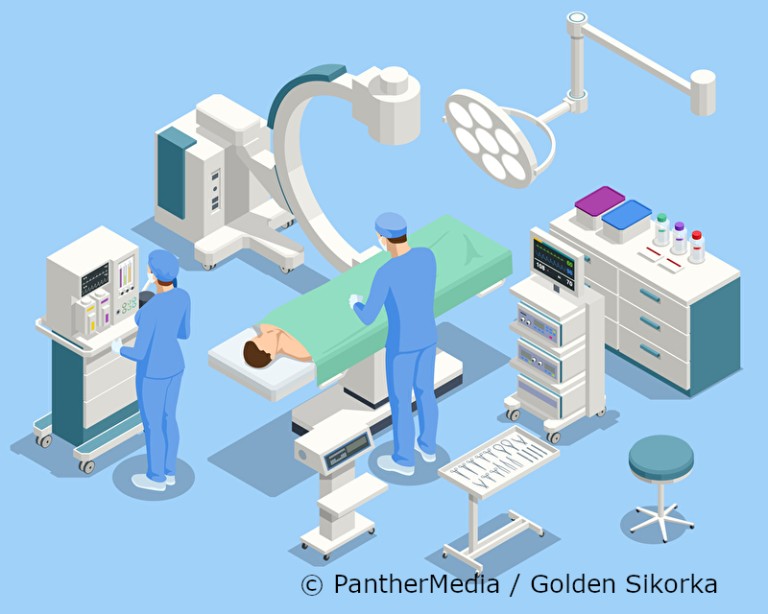1. What are non-drug interventions?
The group of non-drug interventions or examination and treatment methods assessed by IQWiG includes a wide range of medical applications and interventions. Drugs as a stand-alone component are not included, even though they are sometimes part of the intervention. Lifestyle interventions such as fitness training, cosmetic surgery or certain massages are also not included in this category, as they do not primarily serve medical purposes. Medical devices, on the other hand, are often part of such examination and treatment methods.
In addition to their use in treatment, non-drug interventions are used in diagnostics, including screening. They are used both in inpatient care in hospitals and in outpatient care in medical, psychotherapeutic, physiotherapeutic or logopaedic practices.
The range of medical devices used within these examination and treatment methods extends from simple, inexpensive consumables such as plasters, bandages or syringes to walking aids or dentures and to large-scale equipment with multi-million investment costs (e.g. surgical robots or magnetic resonance imaging, MRI). However, non-drug interventions also include treatment methods without products, for example in psychotherapy. Diagnostic tests (including screening) cover hearing and vision tests as well as imaging to detect colorectal cancer, ultrasound during pregnancy or genetic tests for breast cancer or trisomy 21 markers.
This variety of interventions covers a broad spectrum of risk classes. While, for example, a pulse oximeter for use outside the body to determine the blood’s oxygen saturation is not associated with a direct risk for the patient, the situation is quite different for interventions in which a product remains in the body, such as artificial joints or heart valves.
Challenges in the assessment
The diversity of the interventions poses a particular challenge in the assessment of their effectiveness, benefit and harm.
A fundamental difference versus drugs exists in the approaches for benefit-risk assessments. Whereas to be approved, drugs must first prove their efficacy in a clearly regulated process and then prove their added benefit for reimbursement in the statutory health insurance (SHI) system (see "In the focus: New Drugs – approval, benefit assessment, coverage"), there is no such simple, fixed approach for non-drug interventions.
Just as there is a diversity of non-drug interventions, a diversity of assessment pathways and access points into the healthcare system also exists. For example, new medical devices must have certification, but this does not apply to new psychotherapy techniques.
For inpatient treatment in hospitals, almost all new interventions can be introduced very quickly based on the so-called NUB process (“Neue Untersuchungs- und Behandlungsmethoden”, new examination and treatment methods) and are reimbursed by the SHI funds without having to prove an (added) benefit. An assessment only has to be performed for inpatient treatment methods if the method is particularly invasive, truly new and expensive, and based on the use of a medical device. In contrast, new outpatient treatment methods used in doctors' offices, for example, must always have a proven benefit before the SHI will cover the costs.
The assessment of effectiveness, benefit and harm is also associated with some specific features in the case of non-drug interventions. For example, these parameters can depend heavily on the experience of the applier. An X-ray can often only improve treatment if a qualified and trained person evaluates the image.
Blinding is often not possible in studies of non-drug interventions, making assessment difficult. For example, when comparing a surgical intervention with a non-surgical intervention in a study, patients and hospital staff generally know which treatment was performed and may then tend to attribute a better outcome to surgery.
Another special feature is the assessment of diagnostic tests: They do not have a direct positive effect on the patient's health, as may be the case with drugs. For this reason, the subsequent treatment must also be included in an assessment. For instance, although a laboratory test can detect a heart attack, the patient only benefits from it if the heart attack can also be treated after diagnosis and this leads to better results.
Moreover, distinguishing between individual interventions is not always easy, which has an influence on whether an intervention is assessed at all. Since only truly new interventions are assessed, the question always arises as to whether a "new method" is actually a genuine innovation (“leap innovation”) or whether a comparatively minor improvement has been made (“step innovation”), for which a separate assessment may not even be necessary.
image: © PantherMedia / Golden Sikorka




